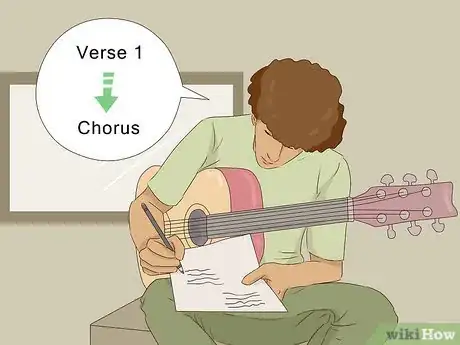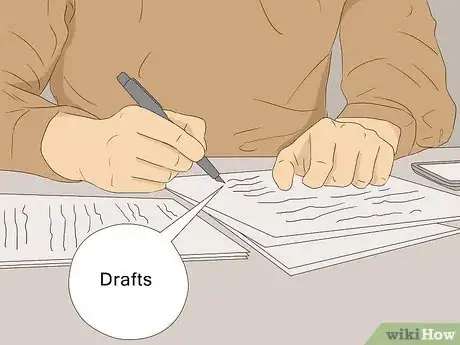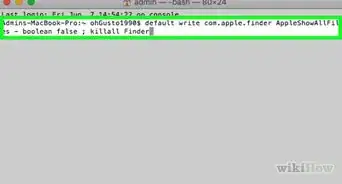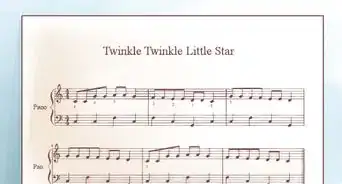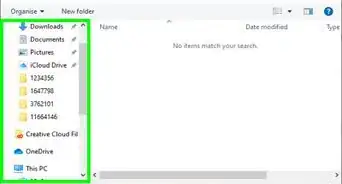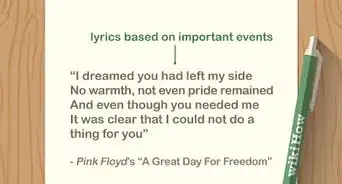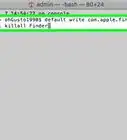This article was co-authored by Tanisha Hall. Tanisha Hall is a Vocal Coach and the Founder and Executive Director of White Hall Arts Academy, Inc. an organization based in Los Angeles, California that offers a multi-level curriculum focused on fundamental skills, technique, composition, theory, artistry, and performance at a conservatory level. Ms. Hall's current and previous students include Galimatias, Sanai Victoria, Ant Clemons, and Paloma Ford. She earned a BA in Music from the Berklee College of Music in 1998 and was a recipient of the Music Business Management Achievement Award.
There are 13 references cited in this article, which can be found at the bottom of the page.
This article has been viewed 150,381 times.
The first few moments of any song are arguably the most crucial. Since the listener tends to start forming judgments of what they’re hearing right away, it’s necessary to craft an opening that will grab them and keep them hooked until the end. No matter how much experience you have as a songwriter, you can make a better first impression with your music by sharpening your lyrical focus, inventing catchy, memorable melodies and making sure they fit together in a way that sounds natural.
Steps
Writing the Lyrics
-
1Come up with a central theme or idea. Decide what your song is to be about. Rather than choosing a general topic like love or the hardships of life, brainstorm specific images and ways that you might develop them into a piece of music. A focused approach will allow you to generate more conceptual material to work with.[1]
- A fleshed out premise like “an uncompromising business man struggles to form a connection with his dying father” is stronger than a barebones one like “loss of a loved one.”[2]
-
2Set the scene. Use your opening lines to lay out any important details that will come into play later in the song. This will provide the listener with the key elements they’ll need to make sense what they’re hearing. It will also serve to draw them in, making them want to find out what happens.[3]
- Describe your main character or conflict within your first few lines to set the stage for the chorus and later verses.
Advertisement -
3Use evocative language. Start by committing your main ideas to paper, then go back and refine them later. Draw on devices like simile and metaphor to tell your story in a way that’s engaging to the listener. Don’t just explain the action—give life to it through concrete images and unexpected turns of phrase.[4]
- Take advantage of colorful “sense” words, including visuals, sounds and even scents.
- Vivid language is often the difference between telling the audience what’s going on and painting a picture for them.
-
4Establish a rhyme scheme. A tight rhyme scheme will keep your listener’s mind busy trying to fill in what comes next. This kind of active participation effectively gets them more involved. Take cues from your favorite songwriters and pay attention to the way they use rhyme to highlight prominent ideas and draw attention to certain lines.
- Start with a simple A-B-A-B rhyming style where every two lines end in the same sound, or try out a more intricate structure like A-A-B-B.[5]
- Not every song needs to rhyme. In some compositions, a rhyme pattern will sound too sing-songy, which can lessen the impact of the music and lyrical content.
-
5Determine the right length. Strive to write a verse that can be sung in around a minute or less. Any longer than that and you run the risk of boring your listener. Any shorter and the arrival of the chorus may be sudden and jarring.[6]
- The number of lines in your verse will depend largely on the song’s unique tempo and pacing.
- Recite the lyrics of the verse back to yourself (or better yet, sing it if you’ve already got a melody worked out) to get a sense of how the timing will sound in performance.
Crafting the Music
-
1Translate feeling into sound. Consider the mood you’re trying to capture and what sorts of sounds you associate with that mood. To keep things simple, narrow down a single key or range of notes that represents the emotions you hope to provoke. You can then build from there with a particular scale in mind.[7]
- For an upbeat song about living your dreams, you’ll most likely want to call upon the major scale and a snappy tempo, whereas sadder songs will typically sound slower and more subdued.[8]
-
2Create a distinct melody. Keep the core theme you’re trying to express in the forefront of your mind while exploring different sounds. The notes and chords you string together should have their own sort of logic, but not be so complex that the listener can’t hum along. Their reaction will be determined by the first few strains they hear, so you want to make sure they’re memorable.[9]
- Sit down with an instrument or use your voice to tinker with a tune.
- It’s generally easier to tailor the melody to the lyrics and not the other way around.[10]
-
3Select an appropriate tempo. Like the key, the particular time signature your song is written in should reflect your desired tone. In many ways, the pacing of the song will be responsible for shaping the listener’s experience. There are no set rules when it comes to tempo—let your intuition guide you and go with what sounds like a natural fit.[11]
- Experiment with different time signatures until you hit on one that carries your song along at the right speed.
Bringing it all Together
-
1Start at the end. If you find yourself hung up, it can sometimes help to work in reverse. Switching up the order of events will allow you to look at things from a different angle. As a result, it becomes possible to fit the disjointed pieces of your narrative together and reframe them in an unconventional way.[12]
- For example, in a song about a wild party, you could open by describing the aftermath—the trash strewn about the room and the guests passed out on the lawn—then go back and recount how things got to that point.
- Don’t be afraid to jump around in time if it makes the story you’re telling more compelling. Devices like flashbacks and foreshadowing are fair game in songwriting.[13]
-
2Transition smoothly into the chorus. As you work your way towards the chorus, pick out melodies that strike a different emotional chord than the verses. This is arguably the most important section musically, as it’s how the song will come to be identified. Once it arrives, the listener should feel like the whole song has been building to that moment.[14]
- The chorus is often composed in a higher pitch than the verses to help suggest that the content is more emotionally charged.[15]
- It may help to incorporate a short bridge section that makes the introduction of the chorus a little smoother and creates contrast between it and the verses.[16]
- Stick to the same basic key and tempo, at least for your first few efforts. A sudden shift in the middle of the song may be offputting.
-
3Write multiple drafts. Odds are you won’t produce a hit on your first few tries, and that’s okay. Sometimes a verse will have to go through countless rewrites before the music and lyrics come together just right. Keep at it—with each new draft, your song will be that much stronger.[17]
- After you finish writing your verse, step away and come back later to look at it with a fresh perspective.
- The more time you spend in the writing phase, the longer you’ll have to distill your ideas into a form that’s faithful to your original vision.[18]
Expert Q&A
-
QuestionWhat is the first part of a song called?
 Tanisha HallTanisha Hall is a Vocal Coach and the Founder and Executive Director of White Hall Arts Academy, Inc. an organization based in Los Angeles, California that offers a multi-level curriculum focused on fundamental skills, technique, composition, theory, artistry, and performance at a conservatory level. Ms. Hall's current and previous students include Galimatias, Sanai Victoria, Ant Clemons, and Paloma Ford. She earned a BA in Music from the Berklee College of Music in 1998 and was a recipient of the Music Business Management Achievement Award.
Tanisha HallTanisha Hall is a Vocal Coach and the Founder and Executive Director of White Hall Arts Academy, Inc. an organization based in Los Angeles, California that offers a multi-level curriculum focused on fundamental skills, technique, composition, theory, artistry, and performance at a conservatory level. Ms. Hall's current and previous students include Galimatias, Sanai Victoria, Ant Clemons, and Paloma Ford. She earned a BA in Music from the Berklee College of Music in 1998 and was a recipient of the Music Business Management Achievement Award.
Vocal Coach Well you could have the introduction, which leads into the first verse. Some songs put a chorus at the beginning before the first verse. Then, before you finish the first chorus, you can include a bridge, which is a kind of creative transition where the tone or beat may change before the hook. Honestly, there are so many ways to go when it comes to structuring a song, so don't focus too much on the structure if you're writing music. Instead, focus on the lyrics, notes, and melody and then put it all together in a way that makes sense.
Well you could have the introduction, which leads into the first verse. Some songs put a chorus at the beginning before the first verse. Then, before you finish the first chorus, you can include a bridge, which is a kind of creative transition where the tone or beat may change before the hook. Honestly, there are so many ways to go when it comes to structuring a song, so don't focus too much on the structure if you're writing music. Instead, focus on the lyrics, notes, and melody and then put it all together in a way that makes sense. -
QuestionIs there any medical way to expand my vocal chords?
 Community AnswerDo you mean expand your range of the notes you can sing? If that's what you mean, you can work on vocal technique that will definitely expand your range and improve your voice immensely without medical help (which I don't even think is available for that). I suggest getting vocal lessons with a good teacher who knows what they're doing.
Community AnswerDo you mean expand your range of the notes you can sing? If that's what you mean, you can work on vocal technique that will definitely expand your range and improve your voice immensely without medical help (which I don't even think is available for that). I suggest getting vocal lessons with a good teacher who knows what they're doing. -
QuestionHow do you come up with a beginning verse for a harmony song?
 Community AnswerUse whatever flows with the music that makes you feel something.
Community AnswerUse whatever flows with the music that makes you feel something.
References
- ↑ https://www.musicindustryhowto.com/how-to-write-a-song-for-beginners-a-step-by-step-guide-to-becoming-a-songwriter/
- ↑ https://songtown.com/writing-first-song2/
- ↑ http://www.writerswrite.com/journal/jul00/build-a-song-part-vii-the-emergence-of-the-7005
- ↑ https://www.cliffgoldmacher.com/write-better-lyrics/
- ↑ http://nicholastozier.com/have-you-mastered-all-six-of-these-basic-rhyme-schemes/
- ↑ http://www.writerswrite.com/journal/jul00/build-a-song-part-vii-the-emergence-of-the-7005
- ↑ Tanisha Hall. Vocal Coach. Expert Interview. 27 March 2020.
- ↑ http://www.audiomasterclass.com/how-to-find-the-best-tempo-bpm-for-your-recording
- ↑ http://edmprod.com/ultimate-melody-guide/
- ↑ https://www.musicindustryhowto.com/how-to-write-a-song-for-beginners-a-step-by-step-guide-to-becoming-a-songwriter/
- ↑ http://blog.discmakers.com/2014/09/dont-limit-your-songwriting/
- ↑ http://www.musesmuse.com/patart.html
- ↑ http://education.seattlepi.com/techniques-flashback-foreshadowing-can-dramatic-effect-piece-writing-5044.html
- ↑ http://www.musesmuse.com/patart.html
- ↑ http://www.secretsofsongwriting.com/2014/07/25/5-main-differences-between-verse-and-chorus-melodies/
- ↑ Tanisha Hall. Vocal Coach. Expert Interview. 27 March 2020.
- ↑ https://www.musicindustryhowto.com/how-to-write-a-song-for-beginners-a-step-by-step-guide-to-becoming-a-songwriter/
- ↑ http://omarimc.com/45-songwriting-tips-techniques-ideas/










